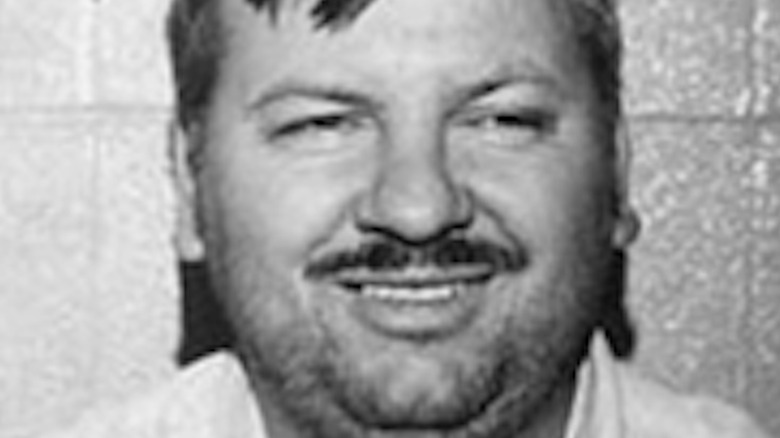Why John Wayne Gacy Only Served 18 Months After Receiving A 10-Year Prison Sentence
When police began searching the Chicago home of John Wayne Gacy in 1978, the world had no idea what kind of carnage they were about to uncover. Over the last several years, Gacy had been luring young men and boys into his home so that he could torture, rape, and murder them (per Biography). Many of his victims were carefully placed in the crawlspace under his home, going undetected until investigators began to exhume body after body.
While he was the subject of police surveillance on several occasions leading up to his arrest, no one suspected the sheer level of brutality that Gacy was capable of committing. But digging into his past, police were able to uncover an arrest in 1968 that landed him in an Iowa prison (via The New Yorker). The charges that led to this arrest were forcible sodomy on two teenage boys, both of whom swore statements against Gacy, who was 26 years old at the time.
The crimes against these teens were chilling precursors of what Gacy was truly capable of. Though in the hands of the criminal justice system, Gacy was released from the grasp of the law far earlier than many feel he should have been, resulting in the needless deaths of more than 30 innocent victims who would otherwise still be alive today.
If you or anyone you know has been a victim of sexual assault, help is available. Visit the Rape, Abuse & Incest National Network website or contact RAINN's National Helpline at 1-800-656-HOPE (4673).
He was living an ideal life on the surface
John Wayne Gacy married well as a young man. The New York Times reports that he met his first wife, Marlynn Myers, while the two worked NunnBush Shoe Company in Springfield, Illinois. They married nine months after becoming acquainted, moving into a house owned by Myers' parents.
Gacy's in-laws had purchased several franchises of the growing Kentucky Fried Chicken restaurant chain, opening several stores in the city of Waterloo, Iowa. Gacy and his wife moved to Waterloo in 1966, with Gacy moving into the role of assisting his father-in-law in managing the fast-food locations. An active member of the Jaycees while he lived in Springfield, Gacy became an enthusiastic member of this service club in Waterloo, becoming elected the chapter vice president and serving in the role of chaplain.
Everything seemed to be going Gacy's way. He and his wife were soon the proud parents of two young children, he was blossoming as a manager at the local KFCs in Waterloo, and he was getting his name recognized as an active member of a well-known service organization. But whatever abnormalities drove Gacy's darkest desires began to rear their ugly heads in 1968, leading to his first arrest.
The crime that landed Gacy a 10-year sentence
John Wayne Gacy's first brush with the law was in 1968, when two teenage boys testified against him in front of a grand jury (per The New Yorker). The two were subjected to unwilling advances by Gacy, one of which provided a chilling bit of foreshadowing for what Gacy would later expose his murder victims to in Chicago.
The first incident happened while Gacy's wife was away from home one afternoon in 1968, and he invited a teenage boy over. The youth had been hired by Gacy to spread gravel on his driveway. The boy testified to a grand jury later that Gacy showed him several pornographic films before coercing him into giving and receiving oral sex. The boy further testified that there were several occasions in the fall of 1968 where he accepted money in exchange for sexual favors from Gacy.
The second youth worked for Gacy at one of the KFCs that he managed. After work one day, Gacy drove the teen back to his home while his wife was in the hospital giving birth to their second child. The teen boy testified that Gacy showed him pornographic movies, then attacked and nearly strangled him.
After an indictment was returned against Gacy, the defendant hired a high school senior to intimidate his two accusers. One of the boys was driven to the woods and maced and beaten on Gacy's orders. After escaping, the victim reported the incident to the police, who questioned his attacker. The culprit stated that Gacy offered to pay off his car loan if he could keep the teen from testifying against him.
His defense argued for probation
During his trial, John Wayne Gacy's attorney tried to no avail to get him released on probation. Gacy pleaded guilty to the sodomy charge on November 7, 1968, in exchange for other charges against him being dropped. His attorney, Al Frerichs, pleaded with the judge, citing Gacy's standing in the community and his exemplary work ethic (per Waterloo Courier).
Frerichs goes so far as to state that Gacy "would be exposed to many problems in prison" and that the best possible solution would be to turn Gacy over to the custody of his wife and family. With a sentence of probation, Gacy would be able to maintain his employment and be able to work at being a better member of society. Prison, in the words of Frerichs, would only serve to make Gacy a worse person than he was before going in.
The judge dismissed those arguments and sentenced Gacy to prison. With the justification being that Gacy gained the confidence of youths and betrayed it to satisfy his selfish carnal desires, Judge Peter Van Metre sent the defendant on his way to what should have been a lengthy stint in the slammer.
He was sentenced to 10 years in prison
In spite of the pleas of his attorney, John Wayne Gacy was sentenced to serve 10 years in prison for the sodomy charge. He was sent to serve his sentence in the Fort Madison State Penitentiary, leaving behind his wife and children.
Gacy was reported to be a model prisoner during his time at Fort Madison, so much so that he was granted parole after only 18 months behind bars (per The New York Times). After Gacy was arrested and awaiting trial for the murder of 33 men and boys in his Chicago home in 1978, The New York Times interviewed Calvin Auger, who served as Warden when Gacy was imprisoned in Iowa. "He had no particular problem during his stay," the Warden told the media outlet. Auger went on to say that Gacy was well-adjusted in the institution and a hard worker. Gacy excelled as part of the kitchen staff during his time in prison, perhaps channeling his experience at the KFCs that he managed for his father-in-law on the outside.
Donald L. Olson, who was a member of the Iowa State Parole Board when Gacy was released from their system in 1970, refused to divulge any information from the psychological exams that Gacy was subjected to prior to the parole board's decision to release him. Claiming that the records were medical and therefore confidential, Olson did state that if there were "any red flags," Gacy would not have been paroled by the board.
Without knowing what they were about to unleash on the world, the parole board granted Gacy his freedom.
Gacy couldn't keep his hands clean for long after he was paroled
John Wayne Gacy's wife divorced him while he was doing his time in prison. Claiming "cruel and inhuman treatment" as grounds for the legal dissolution of their marriage, Marlynn Gacy was awarded custody of their two children (via The New York Times). After his release, the newly freed Gacy had but two conditions of his parole. First, he would have to abide by a strict curfew of 10 p.m., which would be monitored by the Iowa Board of Parole. The second condition was that he be relocated to Chicago, where he could live with his mother (per Cohen & Cohen).
There was one known incident that could have put Gacy behind bars had it played out more in the favor of Chicago prosecutors. On February 12, 1971, Gacy Chicago police arrested Gacy not even four months after his release from prison. A teenage boy had filed a report that Gacy had picked the youth up from a local bus station and attempted to force a sexual act on him. Unfortunately, the charge against Gacy was dismissed when the teen failed to show up to court.
Officials in Iowa did not learn of the arrest until after they had released Gacy from his parole in October of 1971. His record now sealed, Gacy was able to have more freedom while moving about the streets of Chicago, which would later culminate in the murders of nearly three dozen innocent victims. Had parole officials known of his arrest in Chicago, history might have played out quite differently for those victims and their families.





